Children's social work statistics Scotland 2015-2016
The latest data on children and young people looked after, on the child protection register and in secure care.
This document is part of a collection
Child Protection
 |
Second consecutive decrease in headline numbers on register against long-term trend |
 |
Numbers of registrations and deregistrations have declined, and are close to parity this year |
 |
Causes for concern relating to parental substance misuse and domestic abuse are the most prevalent |
This section presents data on children on the child protection register from 1 August 2015 to 31 July 2016. This will be referred to as 2016 for ease of reporting (with 2014-15 referred to as 2015 etc.). Child protection means protecting a child from abuse or neglect. This can either be in cases where abuse or neglect has taken place, or in cases where a likelihood of significant harm or neglect has been identified. The risk of harm or neglect is considered at a Child Protection Case Conference. Where a child is believed to be at risk of significant harm, their name will be added to the child protection register (a child protection registration).
2015-16 was the fourth year that child protection data has been collected entirely at individual level. As the series has lengthened, more in-depth validation of the data has been possible, which gives a high level of confidence in its accuracy. Some of the 2015 figures in this publication have been revised as part of the 2016 validation process.
Children on the child protection register
Chart 4 shows that the number of children on the child protection register has fluctuated regularly, but there is a general upwards trend. However, in the last two years there has been a slight decrease, which may be the start of a longer term decline, but it is too early to know. This is the first time since 2005 that there have been two consecutive years of decline. The total has increased by 33% between 2000 and 2016 (from 2,050 to 2,723). Following updated information from local authorities, the 2015 data have been revised down slightly from the initial published figure from 2,751 to 2,741. The number of children registered in 2016 is slightly lower than last year (by one per cent). It should be noted that relatively large year-on-year changes are experienced in a number of local authorities (see Table 2.2 for local authority level breakdowns).
Chart 4: Number of children on the child protection register by age, 2000-2016
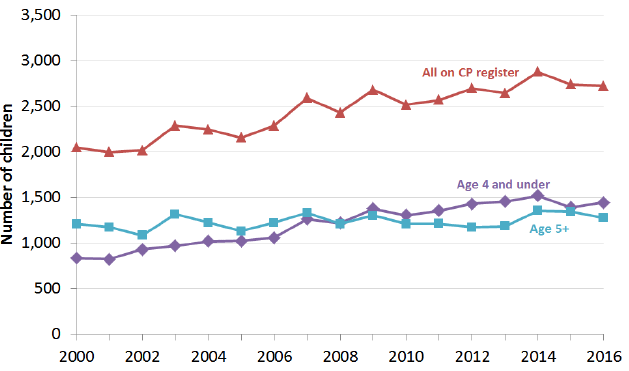
In 2016, 53% of children on the child protection register were aged under five. Since 2008 there have been more children aged under five than over five on the child protection register, and the gap has widened again in 2016, after it closed in 2014 and 2015 . In 2016, there was a four per cent increase in the number of those aged 5 and under, after a fall between 2014 and 2015. In contrast, there has been a fall of five per cent in the number of children aged over five, continuing last year's decline.
There is no strong gender pattern among children on the child protection register - 49% were boys, 47% were girls and the remaining four per cent were unborn children. Because of a change in how unborn children were recorded by local authorities in 2010, figures for unborn children are only comparable from 2011 onwards.
Table 2.1: Number of children on the child protection register by gender (1)

(1) Full data by gender and age group for 2000-2015 is available in Table 2.1 of the excel version of the publication tables.
(2) Source: National Records of Scotland, 2015 mid-year population estimates.
Table 2.2 shows that 3.0 children in every 1,000 children under 16 were on the child protection register in Scotland in 2016. At local authority level the rate varied from 0.3 per 1,000 children in Orkney to 5.2 per 1,000 children in Glasgow.
As is often the case, there is a lot of variability from year to year in the numbers of children on the child protection register at a local authority level. In many cases, there are no obvious reasons for changes, although in some areas, sibling groups entering and leaving the system has led to fluctuating numbers.
Table 2.2: Number of children on the child protection register and rate (1) per 1,000 population aged 0-15 by local authority, 2006 and 2016
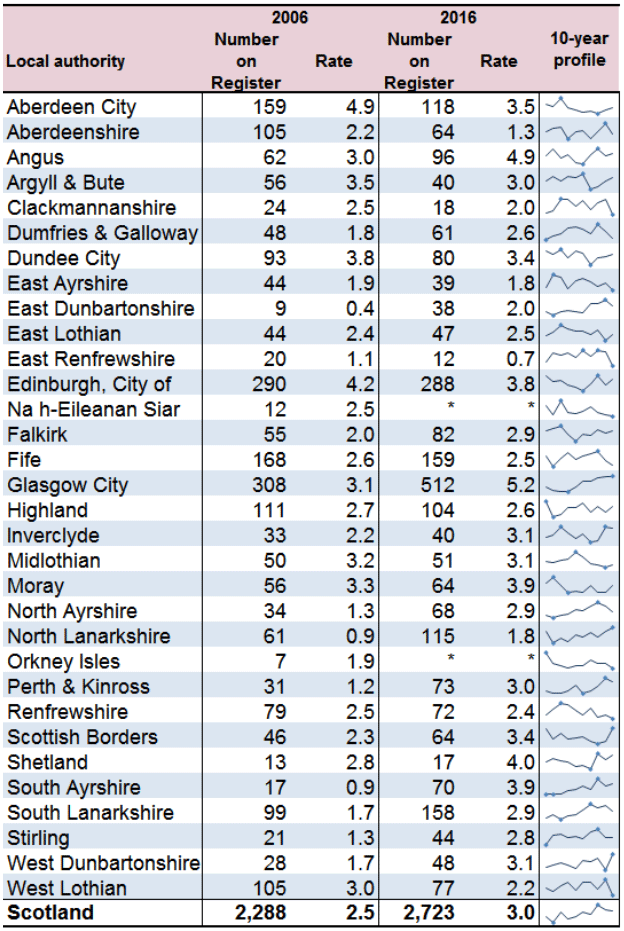
(1) Calculated using National Records of Scotland 2015 mid-year population estimates.
Chart 5: Concerns identified at the case conferences of children who were on the child protection register, 2016
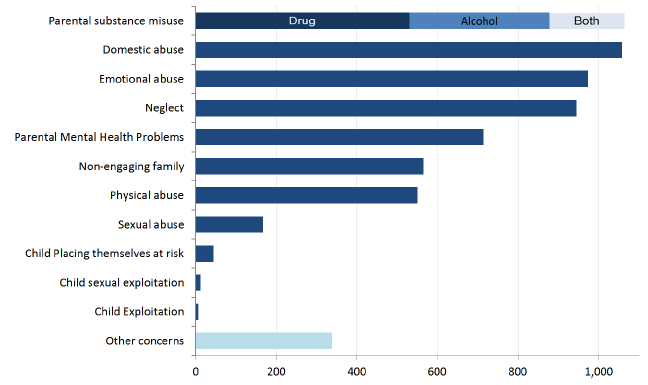
Since 2012, multiple concerns can be recorded at each case conference (rather than just the main category of abuse). This means that the total number of concerns is larger than the total number of registrations, and that figures on concerns identified from 2012 onwards are not comparable to previous data on category of abuse/risk. For the 2,723 children on the child protection register at 31 July 2016, there were 6,439 concerns at the case conferences at which they were registered - an average of 2.4 concerns per conference. Chart 5 shows the most common concerns identified were parental substance misuse (39% of case conferences recorded this concern), domestic abuse (39%), and emotional abuse (36%).
Child protection registrations and deregistrations
The number of registrations to the child protection register increased between 2010 and 2014, and has decreased in the past two years. The proportion returning to the register after previously being deregistered is at 17% this year, and has consistently remained between 14 and 17% in recent years. Table 2.3 shows that the length of time between these periods of registration is generally increasing, with many more having been off the register for more than two years.
Table 2.3: Number of registrations following an initial, pre-birth or transfer-in case conference by length of time since previous deregistration
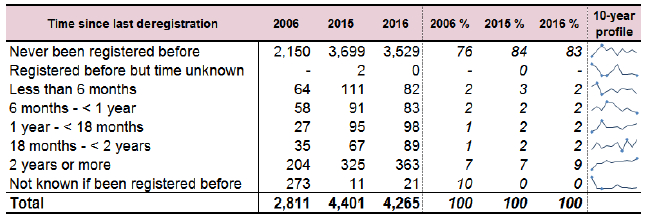
Table 2.4 shows the numbers of deregistrations. There were fewer this year, which is the first decline since 2011. There were 4,283 deregistrations from the child protection register in the year to 31 July 2016, a six per cent decrease on 2015, but a 39% increase on 2007. The most common reason for deregistration in 2015-16 (in 55% of cases) was an improved home situation.
Table 2.4: Number of deregistrations from the child protection register by length of time on register and reason for deregistration, 2015-2016
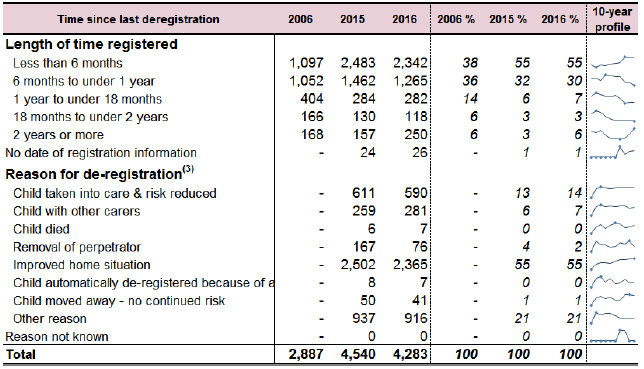
Chart 6: Percentage of deregistrations by length of time on the child protection register, 2007-2016
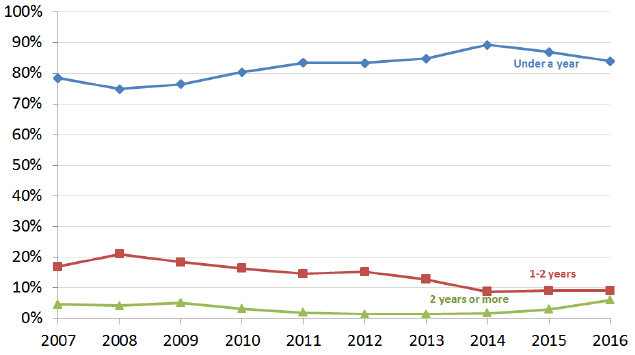
Similarly to registrations, the number of deregistrations from the child protection register also increased between 2010 and 2014, but decreased in the past 2 years (chart 6). The numbers of young people on the register for more than two years has increased at a similar rate to the rate of decline in those spending less than a year on the register, implying a general increase in time spent on the register.
Child Protection Register Geographical Comparisons
Within Scotland
Across Scotland, 17.5 per 1,000 under 18s are looked after or on the child protection register, but there is variation across local authorities. The rate is highest in Glasgow (with 34.8 children per 1,000 under 18s) and lowest in East Renfrewshire, (with 6.8 per children per 1,000 under 18s). In general, rates are higher in the West of Scotland and urban areas.
Cross- UK child protection comparisons
Child protection systems across the United Kingdom vary but are generally comparable. Scotland's collection year runs from 1 August to 31 July, so end‑year figures are typically reported at 31 July in this publication, while the collection year in England, Wales and Northern Ireland runs from 1 April to 31 March (so end-year figures are at 31 March). However, in this chart we report the Scotland figures at the 31st March to allow comparison with the other countries.
Chart 7: Cross-UK comparison of rate of children on the child protection register per 10,000 under 18s, 2004-2016
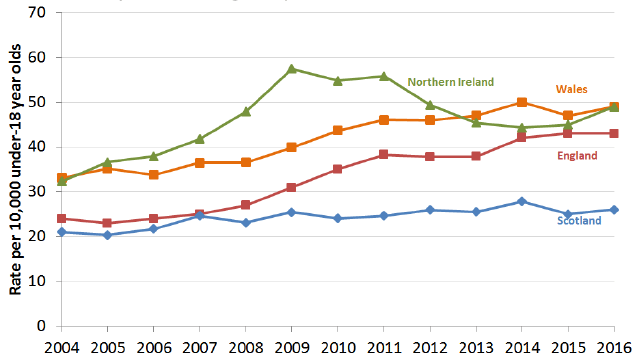
While Scotland has seen an increasing trend in the proportion of children on the child protection register over the last decade, it is not as high as the increases in the rest of the UK. Northern Ireland has been the outlier in terms of its fluctuating trends over recent years, but the rates in the other parts of the UK are very similar, with Scotland remaining notably low.
There are links to the cross- UK data underlying chart 7 in Background Note 1.8 and more information on the comparability of child protection data across the UK here: http://www.gov.scot/Topics/Statistics/Browse/Children/socialservicestats
Additional tables on child protection are available at: http://www.gov.scot/Topics/Statistics/Browse/Children/PubChildrenSocialWork
Contact
Email: Ian Volante
There is a problem
Thanks for your feedback